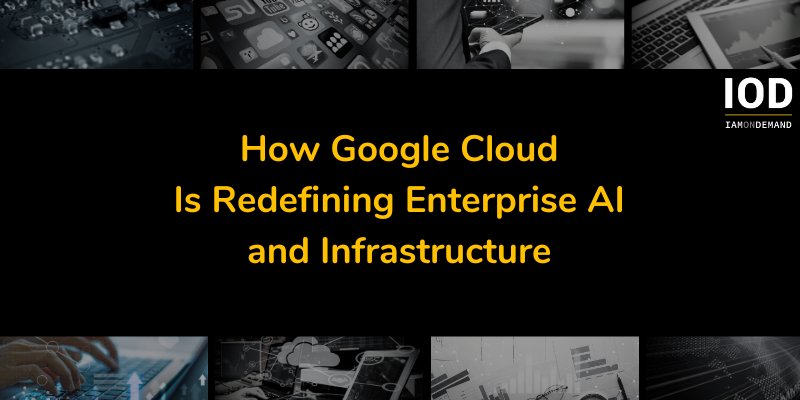Google Cloud Next is just around the corner, promising exciting announcements, insights, and deep dives into the technologies shaping the future of cloud. This year feels particularly special: Google just announced its largest acquisition ever—IOD client Wiz. The acquisition marks a major milestone in the cloud security landscape, and we’re eager to meet with both the Google and Wiz teams to learn more about how this integration will unfold.
As someone who has attended every AWS re:Invent since its inception, and closely tracked Azure developments over the years, I admit my experience with Google Cloud Platform (GCP) has been more limited. But conversations in the community make it clear: GCP is a leader when it comes to data analytics and developer-first innovation.
From BigQuery to TensorFlow, Kubernetes (which started at Google), and Istio, the Google Cloud ecosystem is packed with open-sourced technologies that have reshaped entire industries.
Let’s look at a couple of standout examples of what Google Cloud is doing in real-world scenarios and how it stacks up to the broader market.
Scale, Performance, and the Future of GenAI
One of the most important takeaways for enterprises evaluating Google Cloud is how it handles performance at scale—both in infrastructure and AI innovation. Two recent cases illustrate this well.
Deutsche Börse Group
Google Cloud’s collaboration with Deutsche Börse Group to build a cloud-native trading engine highlights its ability to support latency-sensitive, high-throughput systems in highly regulated environments.
Deutsche Börse implemented a multi-market architecture with direct ingress to Google Cloud, using the global external proxy Network Load Balancer (GEPNLB) to manage TCP/IP and WebSocket traffic. The design includes dedicated Network Endpoint Groups (NEGs) and Google Kubernetes Engine (GKE) clusters for each market, optimized with subnet isolation, single tenancy, and placement policies to reduce network hops and minimize latency.
Cloud Armor provides DDoS protection, while strict FIFO message handling ensures fairness in trading. This shows how Google Cloud infrastructure can power mission-critical systems requiring resilience and precision.
Mercedes-Benz
The partnership between Mercedes-Benz and Google Cloud demonstrates the company’s focus on GenAI and real-time data integration. The new in-car AI assistant, part of the MBUX infotainment system, leverages Google’s Gemini model via Vertex AI. It supports natural, multi-turn conversations, powered by real-time data from Google Maps and enhanced by multimodal reasoning and multilingual support.
This use case points to the growing role of AI in creating intuitive, responsive enterprise-grade user experiences.
Gemini
That said, our own experience with Gemini has been mixed—especially as Google Workspace customers. While the potential is clear, actual usage has sometimes fallen short of expectations. This makes it even more important to learn directly from Google Cloud Next how these technologies are evolving, particularly in production environments.
Products That Matter
When assessing Google Cloud’s place in the enterprise technology landscape, it’s important to start with data and AI—where GCP is increasingly gaining traction.
BigQuery, Google’s fully managed serverless data warehouse, has long positioned Google as a key player in the large-scale analytics market. Recognized as a leader in Gartner’s Magic Quadrant for Cloud Database Management Systems, BigQuery enables fast, SQL-based queries across petabyte-scale datasets and plays a critical role in helping enterprises operationalize data.
BigQuery’s recent integration with Google’s GenAI capabilities—most notably Vertex AI—makes it even more central to next-gen enterprise solutions.
Vertex AI serves as the “AI studio” of Google Cloud, offering tools to build, deploy, and manage machine learning models, including foundation models like Gemini. For companies aiming to experiment or scale GenAI applications, the seamless pipeline from BigQuery into Vertex AI simplifies the journey from raw data to AI-powered experiences.
Complementing these is Google Kubernetes Engine (GKE), a testament to Google’s enduring leadership in cloud-native infrastructure. As the originator of Kubernetes, Google continues to contribute heavily to the open-source ecosystem.
GKE provides a powerful, fully managed environment for running containerized applications at scale and integrates tightly with Google’s observability, networking, and security layers. It’s a strong reminder of how Google’s engineering heritage still shapes the way modern software systems operate.
Looking Ahead: Meet Us at Google Cloud Next
The IOD team will be on the ground at Google Cloud Next this month, and we’d love to connect. Whether you’re interested in AI, security, or the future of infrastructure, there will be no shortage of content and conversations worth joining. As the cloud landscape evolves, Google is clearly doubling down on openness, AI, and vertical-specific innovation.
Need cloud content that converts? Come meet us at Google Cloud Next or RSAC or learn more about our services.

